AMB Labs have been known for making fine audio products, and the Gamma2 is no exception. I find the sound out of the Gamma2 to be very enjoyable. It manages to present a very balanced presentation. Its sound can be considered warm, but not too warm and still enough sparkle to please people who likes detail. There is enough forwardness in the upper midrange to present some intimacy, but it’s never too agressive in its overall presentation. Like other AMB Labs products, the Gamma2 links technicalities with musicality very well.
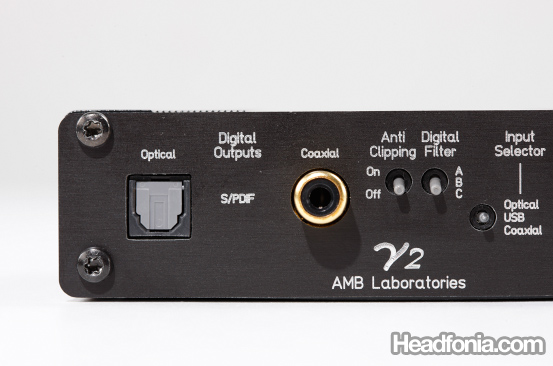
Front panel close up.

Front panel close up.
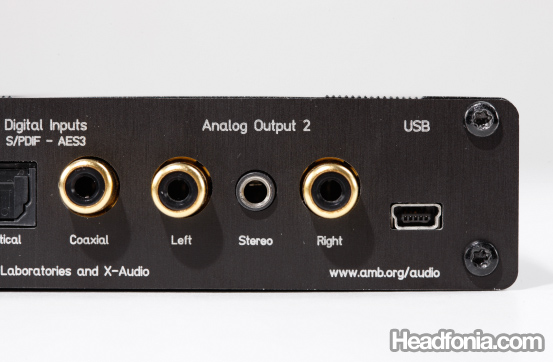
Back panel close up.
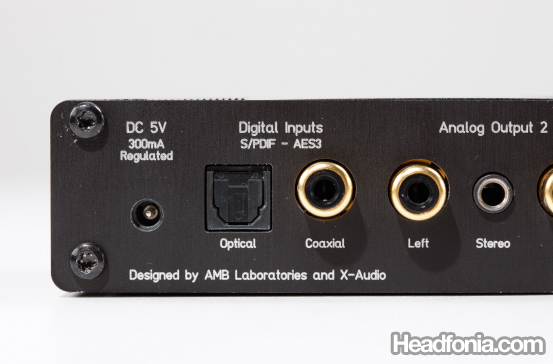
Back panel close up.
When I compared the Gamma2 to the Audinst HUD-MX1, I found the two to have quite a similar sound, and that most people won’t even notice the difference outside of long term A-B listening. I do find the Gamma2 to possess a wider soundstage and a little more detail than what’s found in the Audinst HUD-MX1. The upper midrange on the Gamma2 is also more forward, which adds a nice sparkle and intimacy to the music. In contrast, the HUD-MX1 is a little more laid back in the sound presentation. What I did like about the HUD-MX1 is that soundstage image is more coherent, and that there is more connection between the left and the right soundstage.
I also compared the Gamma2 to the Dr. DAC Prime. The Dr. DAC Prime is more detailed, but at the same time it does have a more recessed midrange (although not as bad as the Ibasso D10). For classical music, a little recessed midrange it’s not an issue, and the added detail on the Dr. DAC Prime is definitely welcome. And also, on some headphones that have enough body in the midrange like the Grado HF2, the HP1000, the HD600, you probably won’t notice the recessed midrange as much. But other than that, for the majority of music that has vocals, I would probably recommend the Gamma2 over the Dr. DAC Prime.
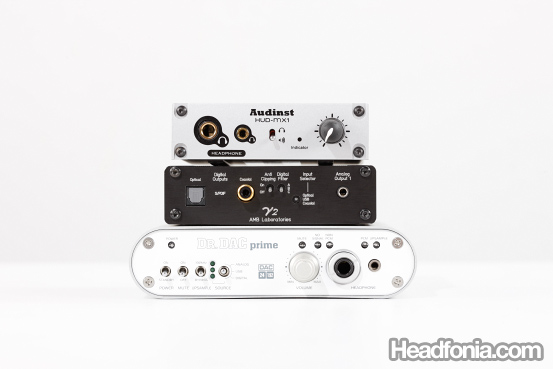
Top to bottom: Audinst HUD-MX1, AMB Gamma2, ESI Dr. DAC Prime.
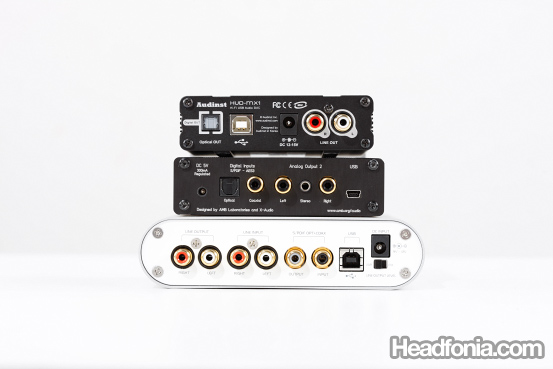
Top to bottom: Audinst HUD-MX1, AMB Gamma2, ESI Dr. DAC Prime.
So, the Gamma2 has found a nice spot in between the $179 Audinst HUD-MX1, and the $499 Dr. DAC Prime. Although if I think about it, for almost $300 in the current configuration (with internal clock and ASRC chip installed, and the Sigma25 power supply), there seems to be little added value in the DIY section, seeing that the Audinst HUD-MX1 is able to sound very close to it, and even throw a headphone amplifier in one package. I think the law of economics is at work here, and that having the advantage of high volume production, the Korean manufacturer is able to still maintain competitive price over the DIY product, where you don’t get discount pricing for the parts, and likely to pay multiple shipping fees to get all the necessary parts from different sources.
This particular Gamma2 build comes with the Wolfson WM8741 which adds a built in digital filters that gives you an option of how you want the frequency response to fall off (likewise the WM8742 also gives that capability):
– Filter C has the most extension, but also comes with the sharpest cutoff.
– Filter B trades some top end extension for a more gradual cutoff.
– Filter A is the compromise between C and B.
I did play around with the filters, and found C to have more sparkle, yet rougher on the edges and more fatiguing, where filter B is softer and more pleasant to the ears. Keep in mind that we’re talking about frequencies way above the audible range. Filter C will go all the way above 40Khz, and filter A and B above 30KHz. How these frequency cutoffs above the audible range affect what we’re hearing in the music? I’m probably not qualified enough to explain.
What about USB input versus the S/PDIF inputs? I ran a cable straight from the MacPro’s optical out, and I compared it to the USB input, and I found no audible difference. I really can’t compare the USB to the coaxial, as the MacPro doesn’t have a coaxial output.





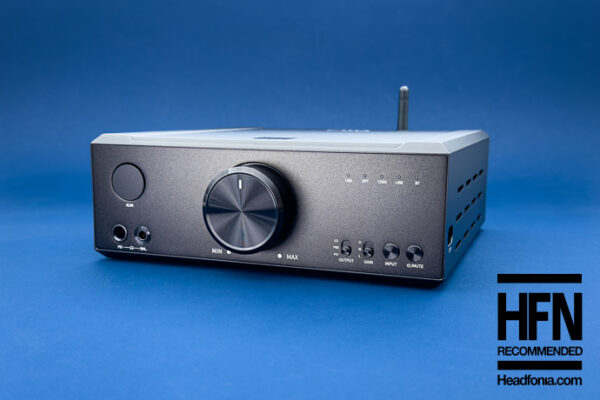
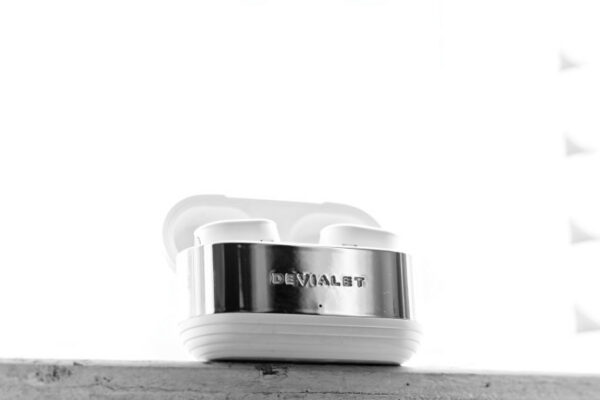
SVM
Nice review!
I wanted to point out a review/discussion on Head-fi forums on Hud-MX1.
http://www.head-fi.org/forums/f7/review-audinst-h…
The reviewer "audiofil" has done some op-amp rolling, from his findings for AD797BRZ x 2 (SOIC pckg. on BD) – I am guessing may be the sound signature is simillar to the coloration of PICO you are referring to.
Mike
Thanks for the link!
Reading the author's comments, he seems to really like the AD797BRZ, but he didn't say enough about the sound that I really can't deduce if it's indeed the "Pico" sound.
I was surprised to hear his comments about the Gamma2, which he found to be more refined, warmer, and fuller sounding. I do agree that the Gamma2 is more engaging and that it has better PRaT than the Audinst HUD-MX1.
thuantran
Hi Mike, sorry to hijack this but I don't know your personal contact. Anyway, an audiophile shop near me has stocked up on Styleaudio Carat-Ruby MkII unit for 340USD. I'm going to audition it this weekend. In case I like it and decide to get it, I might have to push the purchase to next month as someone is going to get annoying if I am to buy it this month. Some comment on specs:
The Topaz is the 2009 version of the original Ruby and in turn Ruby MkII is the 2010 version, what has changed from the Topaz:
– Bigger DC to DC converter unit, leading to bigger depth of the entire unit itself (13cm instead of 12.5cm).
– 24K gold plating PCB.
– Lineout stage output opamp: changed from AD817 to OPA604.
– Accept 24bit/96Khz through USB instead of 16bit/48Khz thanks to Tenor chip.
– Uses PCM1796 instead of PCM1792A, a downgrade in spec but who knows.
– Free voltage adapter with detachable power cord for different standards. IOW you can use the ruby mkII anywhere as long as you have the right power cable.
Jeremy
Nice review, it's something I've been wondering about a while.
Like you note, a lot of the ICs used in the two DACs are the same, but interesting that you found a significant difference between the y2 and the Pico DAC. It might be useful to specify which op-amp was used in your y2's output filter stage (the OPA2365 option is said to be the same used in the Pico DAC section, vs the AD8656) as that could contribute to the sound signature.
Personally one of the reasons I chose the y2 over the Pico was for the additional digital inputs to run off CD players.
Mike
Hi Jeremy,
Sorry for the slow reply as I have to talk to the builder to get that information. This particular Gamma2 uses the AD8656.
Yes, it is a pity that the Pico doesn't come with S/PDIF inputs for hooking up to CD Players. 🙁
Bram
Wow this is a really profound comparison between those DACs. I never thought Pico would be that good! Coz I've always assumed that DIY will always rule over branded stuffs twice as its price or even more and on the other side Pico would easily get beaten by a DIY half its price.
Thanks for the great comparison!
Now it's in between Pico and Audinst for me. 😀
Shahrose
Interesting results Mike. My y2 has the OPA2365, but is otherwise identical to yours (SRC4192, WM8471, external Linear Reg PSU).
I had a chance to compare the y2 and Pico side by side and found little difference (as did others in the setting). I used my HD800 with the M^3/Sigma-11 for the comparison. The subtle differences that I did find favoured the y2 and, surprisingly, some things were actually the opposite of what you've said. For instance, there was more bass weight/punch with the y2, a little smoother upper-midrange/treble and a wider soundstage (depth was about equal). Other than that, there was a striking similarity in sound signatures of both DACs.
Perhaps opamps make a noticeable difference in the y2…who knows.
Oh BTW, I found a noticeable improvement from using the coaxial input instead of USB…but I won't get into that now. I haven't tried optical yet.
Mike
Thanks for sharing your findings Shahrose. Some contradictions in audio can be very puzzling to me. Everything that I heard is what I wrote on the review, and clearly we found different things. Maybe you have build a lemon Gamma2, Shahrose. Just kidding. 😀
Shahrose
Tell that to MisterX, who built it for me. :p
Mike
MisterX? Sshhhh, don't tell him I said that. 😛
Bored
It's pretty obvious which one of you two has a lemon Y2 build. 😉
JJ
Hi Mike,
Have you tried connecting the PICO DAC
to an amp using RCA male to male couplers?
If so, are there any particular brands
you'd recommend or will any coupler be fine?
I'm sorry if I missed it in the review.
Mike
Hi JJ, a local audio guy has been supplying my needs of interconnects. It's pretty high quality, but since its his own build, I don't think it'd be easy for you to get one as he doesn't even have an email. Branded cables, you know these RCA to RCA cables run anywhere from $1 to $1,000 right? 🙂 Just buy a nice looking one at a decent price and enjoy the system for now. 🙂
KK
Hi,
the problem is with the ASRC chip. The AD1896 ASRC chip has a better jitter rejection than the SRC4192; its internal filtering also makes a difference. Getting the AD1896 will make this a fairer comparison.
Internal filters make a lot of differences in DACs.
Anonymous
Thanks for chiming in, KK.